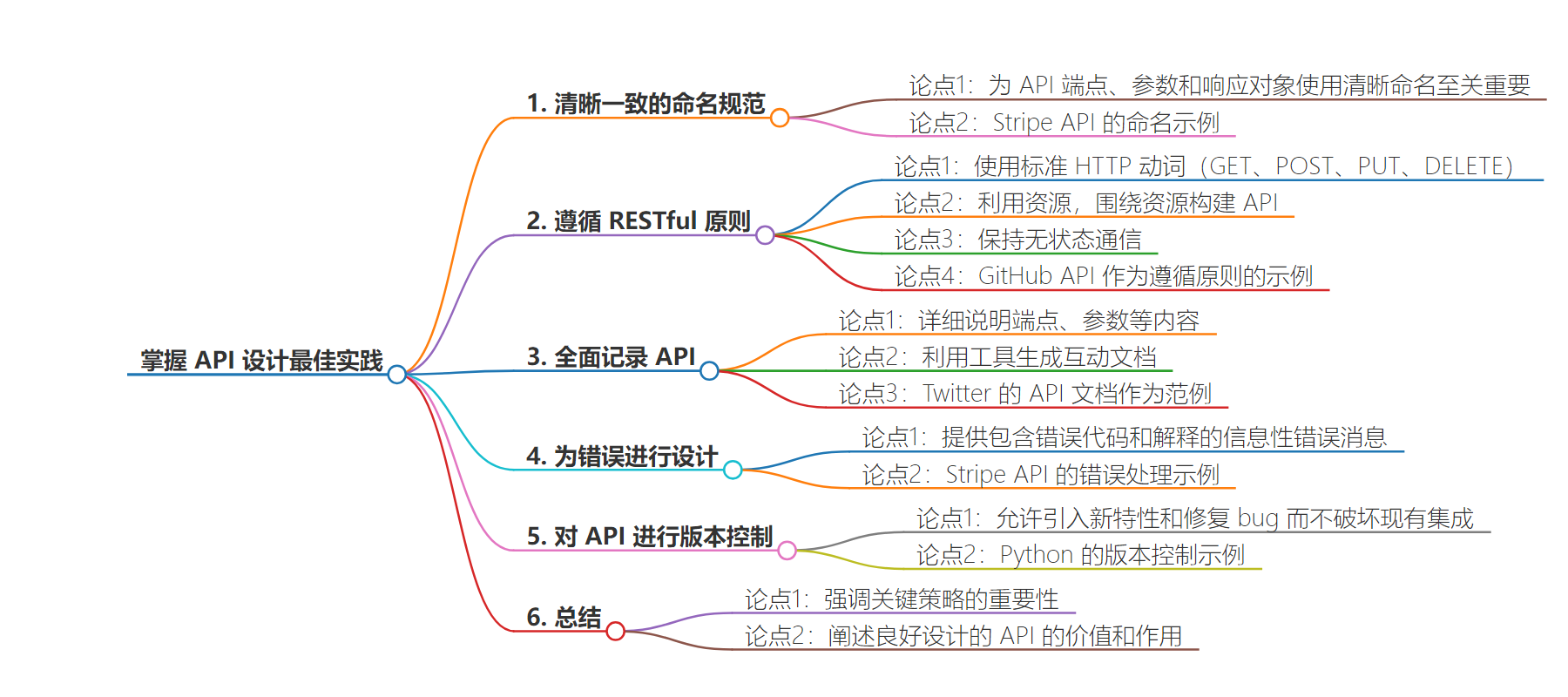包阅导读总结
1.
– `API 设计` 、 `最佳实践` 、 `RESTful 原则` 、 `清晰命名` 、 `版本控制`
2.
本文探讨了 API 设计的最佳实践,包括清晰一致的命名、遵循 RESTful 原则、详尽的文档、优雅处理错误和版本控制,以打造清晰、易用、有价值的 API。
3.
– API 设计的重要性
– 良好设计促进交流,糟糕设计阻碍集成
– API 设计最佳实践
– 清晰一致的命名
– 端点、参数和响应对象命名清晰
– 例如 Stripe API 的命名方式
– 遵循 RESTful 原则
– 使用标准 HTTP 动词
– 以资源为中心
– 保持无状态通信
– 如 GitHub API 遵循该原则
– 全面的文档
– 包括端点、参数等细节
– 利用工具生成互动文档
– 如 Twitter 的 API 文档
– 错误设计
– 提供包含代码和解释的错误信息
– 以 Stripe API 为例
– 版本控制
– 如 Python 的版本方案
– 总结
– 强调最佳实践的重要性,助力项目成功
思维导图:
文章地址:https://www.javacodegeeks.com/2024/07/mastering-api-design-best-practices.html
文章来源:javacodegeeks.com
作者:Eleftheria Drosopoulou
发布时间:2024/7/6 12:44
语言:英文
总字数:756字
预计阅读时间:4分钟
评分:90分
标签:API设计,最佳实践,RESTful原则,文档,错误处理
以下为原文内容
本内容来源于用户推荐转载,旨在分享知识与观点,如有侵权请联系删除 联系邮箱 media@ilingban.com
In today’s interconnected world, APIs (Application Programming Interfaces) play a critical role in enabling communication between different applications and services. A well-designed API acts as a bridge, allowing seamless data exchange and functionality sharing. But a poorly designed API can become a wall, hindering integration and frustrating developers.
This guide dives into the world of API design best practices, equipping you with the knowledge to create clear, consistent, and user-friendly APIs. By following these practices, you’ll ensure your API fosters collaboration and innovation, becoming a valuable asset for developers and your overall project.
1. Use Clear and Consistent Naming Conventions (Like Labeling Your Drawers)
Imagine a cabinet where drawers are labeled with cryptic symbols instead of “Dishes” or “Clothes.” Using clear and consistent naming conventions for your API endpoints, parameters, and response objects is crucial. This makes your API intuitive to understand and minimizes confusion for developers integrating with it.
For example, the Stripe API (https://docs.stripe.com/api) consistently uses PascalCase for naming resources (e.g., Customer, Invoice) and snake_case for parameters and properties (e.g., customer_id, created_at). This consistent approach makes the API easy to navigate and reduces the learning curve for developers.
2. Embrace RESTful Principles (Like Following Traffic Laws on the API Highway)
REST (REpresentational State Transfer) is a set of architectural principles that promote a clean and predictable way to design APIs. By following RESTful principles, you ensure your API is consistent, scalable, and easy to understand. Here are some key aspects of a RESTful API:
- Use standard HTTP verbs: GET for retrieving data, POST for creating data, PUT for updating data, and DELETE for removing data.
- Utilize resources: Structure your API around resources (e.g., users, products, orders) and allow developers to interact with these resources using HTTP verbs.
- Stateless communication: Each request to your API should be independent and not rely on information from previous requests. This makes your API more scalable and easier to integrate with different systems.
A great example of a RESTful API is the GitHub API (https://docs.github.com/pages), which adheres to these principles and provides a clear and predictable way for developers to interact with GitHub data.
3. Document Your API Thoroughly (Like Writing Clear Instructions for Guests)
Imagine inviting guests to your house but not providing any instructions on how to find the bathroom! Excellent API documentation is vital for successful adoption. It should explain how to use your API, including details on endpoints, parameters, request and response formats, authentication methods, and error handling.
Consider using tools like Swagger (https://editor.swagger.io/) or OpenAPI Specification (https://www.openapis.org/) to generate interactive documentation that developers can easily access and explore. The popular social media platform, Twitter, provides comprehensive API documentation (https://developer.x.com/en/docs/twitter-api) that serves as a model for clarity and detail.
4. Design for Errors, Not Just Success (Like Having a Spare Tire on a Road Trip)
Even the best APIs can encounter errors. A well-designed API should handle errors gracefully by providing informative error messages that include error codes and explanations for what went wrong. This helps developers diagnose and fix issues more efficiently.
For instance, the Stripe API uses clear and concise error messages that include a unique error code and a human-readable explanation of the problem. This allows developers to quickly understand the issue and take corrective action.
5. Version Your API (Like Upgrading Your Phone Software)
APIs evolve over time, and it’s important to provide a way for developers to handle these changes. Versioning your API allows you to introduce new features and bug fixes without breaking existing integrations. Developers can then choose to use the latest version or stick with a stable older version if needed.
A well-known example of API versioning is the popular programming language, Python. Python uses a major.minor.micro versioning scheme, allowing developers to stay informed about breaking changes and choose the appropriate version for their needs.
Wrapping Up
In this exploration of API design best practices, we’ve unpacked key strategies to ensure your API acts as a bridge, fostering collaboration and innovation. We’ve emphasized the importance of clear naming conventions, embracing RESTful principles, creating thorough documentation, designing for errors, and implementing versioning. By following these practices, you’ll empower developers to integrate with your API seamlessly and unlock its full potential.
A well-designed API is an investment in the success of your project. It paves the way for smooth collaboration, efficient development, and ultimately, a thriving ecosystem around your creation. So, put these best practices into action and watch your API become a valuable asset for developers and a cornerstone of your overall project!
